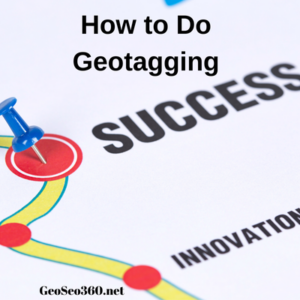What is Geotagging?
Geotagging is the process of adding geographical location data (latitude, longitude, and sometimes altitude) to a photo, video, or other digital content. This information is embedded into the metadata of the file, allowing search engines, mapping services, and social media platforms to recognize the exact location associated with the content.
Geotagging is widely used for local SEO, Google Maps optimization, and social media marketing. Whether you’re a business owner, travel blogger, or photographer, geotagging helps improve search visibility, engagement, and online discoverability.

Why is Geotagging Important?
1. Boosts Local SEO Rankings
Search engines prioritize location-based content. By geotagging images and videos, you help Google understand the relevance of your content to a specific location, improving your rankings in local search results.
2. Enhances Google Maps Visibility
For businesses with a Google My Business (GMB) profile, uploading geotagged photos increases visibility on Google Maps, making it easier for customers to find you.
3. Increases Social Media Engagement
Platforms like Instagram, Facebook, and Twitter use location data to enhance discoverability. Geotagging your posts ensures they appear in location-based searches, reaching a targeted audience.
4. Builds Trust and Authenticity
Geotagging proves that an image or video was taken at a specific location, making it useful for industries like real estate, travel, hospitality, and e-commerce to build credibility.
5. Optimizes Marketing Strategies
Businesses running location-based advertising can use geotagging to target customers more effectively, increasing conversions and ROI.
How to Do Geotagging Step by Step
Step 1: Choose a Geotagging Tool
There are several tools available to add geotags to photos and videos:
- GeoSeo360.net (Online geotagging for photos)
- GeoImgr
- Google Photos (for automatic geotagging on smartphones)
- Adobe Lightroom (for professionals)
Step 2: Upload Your Image or Video
- Open the geotagging tool of your choice.
- Click Upload Image/Video and select the file you want to geotag.
Step 3: Enter Geographical Coordinates
- Manually enter latitude and longitude or select the location on a map interface.
- If you don’t know the exact coordinates, use Google Maps to find them.
Step 4: Add Metadata and Keywords
For SEO purposes, include:
- A description with relevant keywords.
- Business information (if applicable).
- Tags like “best restaurant in New York” or “luxury hotel in Miami Beach”.
Step 5: Save and Download the Geotagged File
- Click Save to embed the geotag data into the file.
- Download the updated file with location-based metadata.
Step 6: Upload Geotagged Content Online
Once your content is geotagged, upload it to:
- Google My Business (GMB) – Increases Google Maps rankings.
- Social Media Platforms – Helps Instagram, Facebook, and Twitter users find your content.
- Your Website or Blog – Enhances SEO for location-based searches.
Best Practices for Geotagging
- Use High-Quality Images – Google and social media platforms prefer clear, well-optimized images.
- Geotag Multiple Photos – More geotagged images provide stronger location signals for SEO.
- Ensure Location Accuracy – Only tag images with their true geographical coordinates.
- Update Geotagged Content Regularly – Keep your location-based content fresh and relevant.
- Optimize Metadata with Keywords – Add location-based descriptions to boost search engine rankings.
Conclusion
Geotagging is a powerful technique to improve local SEO, enhance Google Maps rankings, and boost social media visibility. Whether you’re a business owner, influencer, or marketer, learning how to do geotagging properly can help you reach a larger audience and increase engagement.
Start geotagging your images today with tools like GeoSeo360.net and optimize your digital presence for better search visibility!
